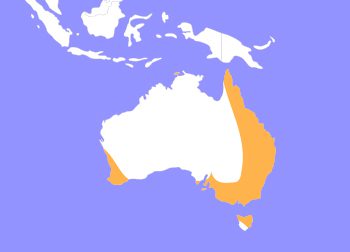Kookaburra (Laughing)
Dacelo novaeguineae
This bird is the national symbol of Australia. They are instantly recognizable by their dark brown eye stripe and wings on their white body. Males will have a blueish tint to their wing and tail feathers. They are also recognizable by the sounds they make. Their territorial calls sounds like a person laughing, or maybe a monkey howling (they have been used in movies to mimic monkey calls). They have two calls: a low “oo oo” and a much louder “ha ha ha”. Their beak is long and very sharp. It is their main tool in prey capture. Kingfishers, the group of birds that Kookaburras are under, are known for their strong diving techniques (in air and water) to catch prey.
They are found mainly in the eastern half of Australia, generally closer to the coasts. Kookaburras are very territorial birds, the sizes of which vary depending on prey availability. They will live in small groups where one will be in charge of the territory and there will be a few helpers to reinforce the territory. Generally these groups are family groups with the parents in charge and older offspring being the helpers. Kookaburras are the least aquatic of the kingfishers; their prey includes much more terrestrial animals such as snakes, lizards, birds, and rodents. They will eat their prey whole but do not digest fur or bones.

Laughing Kookaburras are native to the eastern mainland Australia, and can also be found in the southwestern region. They are also found in Tasmania.
HABITAT -They are found in fairly dense woodlands that are cold and wet.
DIET -They are insectivorous to carnivorous, eating just about anything smaller than it.
FUN FACT -Kookaburras are sometimes called "Bushman's Clock" because their distinctive laugh like call is most often heard at dusk and dawn.
SOCIAL BEHAVIOR -They are territorial but live in groups up to 3 others.
ACTIVITY -They are diurnal, active during the day and sleeping at night.
PREDATORS -Their predators include birds of prey, foxes, and cats.
SIZE -TTheir weight can be about a pound and they grow to a foot and a half long.
RELATIVES -They are related to other kingfishers, such as the Belted Kingfisher found in the U.S.
CONSERVATION -They are listed as Least Concern under the IUCN Red List.
Cub Creek Animal Care Information
Housing - Our kookaburra is housed in the Habitats room in a large enclosure. There are many branches all over his enclosure that give him places to explore and perch on. He is also housed with rabbits as they live on two different levels of the enclosure. He also has a window that allows him to watch what is going on outside.
Diet - Being a carnivorous bird, our kookaburra is alternatively fed frozen hopper mice and uncooked tilapia filet. These are fed in a bowl of water to mimic his natural hunting behavior of fishing. Though the rabbits have a water bowl on the ground that he always has access to, kookaburras gets most of their water through his diet and rarely actually drink water.
Enrichment - Our kookabura gets some enrichment through living in a multi-species enclosure because he can watch the rabbits hop around. They generally do not directly interact. He is also given toys to examine or puzzle boxes that food can be hidden in. These can be made through plastic, cardboard, or any other available material.

